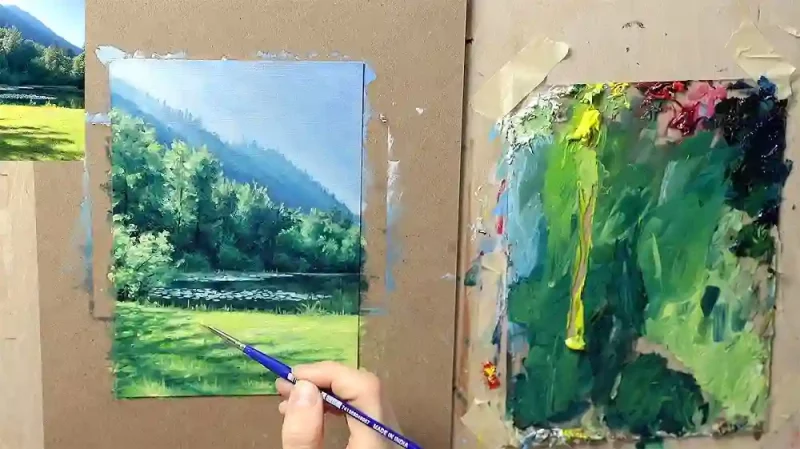In the world of oil painting, size matters. The scale of a painting can significantly influence its visual impact, emotional resonance, and narrative power. Whether you’re working on a miniature masterpiece or a grand, mural-sized canvas, experimenting with different sizes in oil art can open up exciting creative possibilities. In this article, we will explore the impact of scale in oil painting and how artists can use size to convey their artistic intentions.
Understanding Scale in Oil Art
Scale refers to the relative size of a painting compared to the real-world objects it depicts or the space it occupies. The size of a painting can vary widely, ranging from small, intimate works to large, monumental pieces. Each scale choice carries its own set of artistic considerations and effects:
- Miniature Scale: Miniature paintings are typically small in size, often no larger than a few inches in any dimension. These small works require precision and attention to detail. They can evoke a sense of intimacy, delicacy, and intricacy. Miniature paintings are often used for highly detailed subjects like portraits, botanical studies, or miniature landscapes.
- Small to Medium Scale: Paintings of moderate size, which could be framed and hung on a wall without dominating the entire space, fall into the small to medium scale category. These works offer a balance between detail and visual impact. They are versatile and suitable for a wide range of subjects, including still life, portraits, and landscapes.
- Large Scale: Large-scale paintings are characterized by their imposing size and presence. These artworks demand attention and can dominate a room or gallery space. Large-scale paintings often convey grandeur, drama, and a sense of immersive experience. They are ideal for subjects that require boldness, such as abstract art, murals, and epic landscapes.
The Impact of Scale on Artistic Expression
The choice of scale in oil art profoundly influences the way an artwork is perceived and experienced:
- Intimacy vs. Grandeur: Smaller-scale paintings can create an intimate connection between the viewer and the artwork. They invite closer inspection and encourage viewers to appreciate fine details. On the other hand, larger-scale paintings can convey a sense of grandeur and overwhelm the viewer with their sheer size, making them ideal for making a bold statement.
- Emotional Impact: Scale can enhance the emotional impact of an artwork. Small-scale paintings may evoke feelings of tenderness, nostalgia, or subtlety, while larger works can evoke awe, power, or intensity.
- Narrative Possibilities: The scale of a painting can affect its narrative possibilities. Smaller works may tell more intimate, personal stories, while larger works can accommodate complex narratives and encompass multiple elements or characters.
- Composition and Balance: Scale plays a crucial role in the composition and balance of an artwork. Artists must consider how elements within the painting relate to one another and how they interact with the space. This consideration becomes even more critical when working on a large canvas.
- Viewer Engagement: Scale can influence how viewers engage with an artwork. Smaller works may invite viewers to lean in for a closer look, while larger works may encourage viewers to step back and take in the entire composition.
Experimenting with Scale
Artists can experiment with scale to explore different creative possibilities:
- Scaling Up: Enlarging a subject or concept from a smaller work to a larger canvas can reveal new details, textures, and nuances. It allows artists to emphasize the grandeur or drama of their subject.
- Scaling Down: Reducing the scale of a subject or concept can distill it to its essential elements, emphasizing simplicity and intimacy. It can lead to a focus on fine details and intricacies.
- Scale Contrast: Combining artworks of different scales within a series or exhibition can create intriguing contrasts and dynamics. The juxtaposition of miniature works with larger-than-life pieces can engage viewers in a unique visual dialogue.
- Exploring Size Variations: Experimenting with various sizes in a series of paintings can help artists convey different aspects of their subject or explore diverse emotions and perspectives.
Considerations When Choosing Scale
When selecting the scale for an oil painting, artists should consider several factors:
- Artistic Intent: What do you want to communicate or express through your artwork? Your artistic intent should guide your choice of scale.
- Subject Matter: Different subjects may lend themselves better to specific scales. Consider how the subject’s characteristics and narrative relate to the chosen scale.
- Audience and Space: Think about where your artwork will be displayed and who your audience is. The scale should be appropriate for the intended exhibition space and the viewer’s experience.
- Technical Skills: Consider your level of technical skill and comfort with the chosen scale. Smaller works may require exceptional precision, while larger works demand physical stamina and control.
- Budget and Resources: Larger canvases and materials can be more expensive. Consider your budget and access to resources when deciding on scale.
Conclusion
Scale is a powerful tool in the arsenal of oil painters. Whether you opt for the intimacy of a miniature, the balance of a medium-sized canvas, or the grandeur of a mural, your choice of scale can profoundly impact the viewer’s experience and the message your artwork conveys. By experimenting with different sizes and considering your artistic intent, subject matter, and audience, you can harness the potential of scale to create oil paintings that resonate with depth, emotion, and narrative power. Ultimately, the impact of scale in oil art is a testament to the limitless creative possibilities available to artists.

